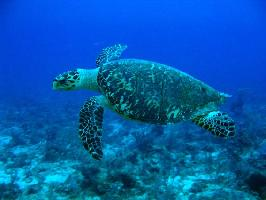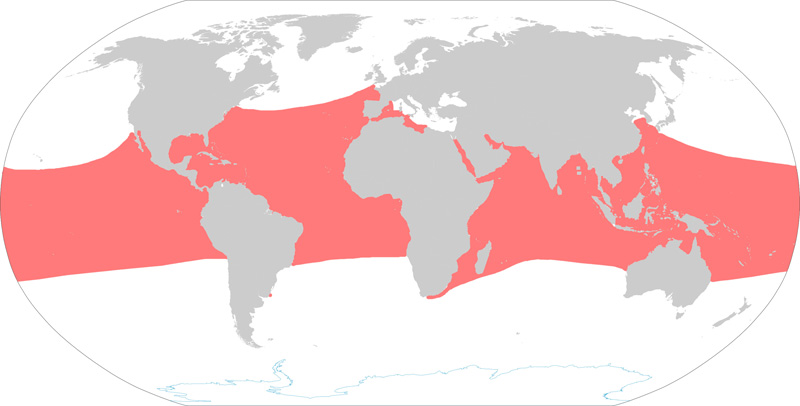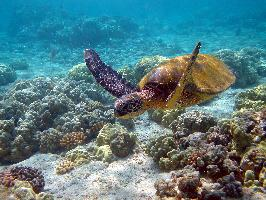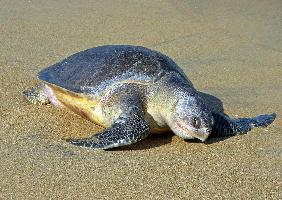
Váhy a míry
| Délka | 100 cm |
|---|---|
| Hmotnost | 80 kg |
Stav ohrožení
| Ohrožen |
Popis zvířete
The Hawksbill sea turtle (Eretmochelys imbricata) is a fascinating marine reptile known for its distinctive appearance and critical role in marine ecosystems. Named for its narrow, pointed beak that resembles a bird's bill, this species of sea turtle is an essential link in the health and stability of coral reefs and seagrass beds. With a geographic range that spans the tropical waters of the Atlantic, Pacific, and Indian Oceans, the Hawksbill sea turtle is a true denizen of the world's warm seas.One of the most striking features of the Hawksbill sea turtle is its beautifully patterned shell. Unlike the smoother carapaces of other sea turtle species, the Hawksbill's shell consists of overlapping scales, or scutes, that create a serrated look along the edges. These scutes are richly colored in mottled shades of brown, amber, and black, creating a stunning natural mosaic that is highly prized in illegal wildlife trade for the production of tortoiseshell items.
Adult Hawksbill sea turtles typically grow to about 2.5 to 3 feet in length and can weigh between 100 to 150 pounds, although larger individuals have been recorded. Their bodies are relatively flattened with a pair of flippers that are adeptly designed for swimming through the open ocean and the intricate structures of coral reefs.
Hawksbill sea turtles are omnivorous, feeding on a variety of marine life, but they have a particular taste for sponges. Their narrow, pointed beaks allow them to extract sponges from crevices in coral reefs, a feeding habit that plays a vital role in the ecosystem. By controlling sponge populations, Hawksbill sea turtles help maintain a balanced reef ecosystem, ensuring that slower-growing coral species are not outcompeted.
Despite their ecological importance, Hawksbill sea turtles face significant threats from human activities. They are critically endangered, primarily due to habitat loss, illegal trade of their shells, accidental capture in fishing gear, and climate change. Their nesting sites are also at risk from coastal development and sea-level rise. Conservation efforts are in place globally, including legal protection, habitat preservation, and research initiatives to better understand their life history and mitigate threats.
Hawksbill sea turtles have a complex life cycle that begins with females returning to their natal beaches to lay eggs. After incubation, hatchlings emerge and make a perilous journey to the sea, where they will spend the majority of their lives. These turtles are known for their long migrations between feeding grounds and nesting sites, a journey that adds to the mystique and wonder of these ancient mariners.
The survival of the Hawksbill sea turtle is crucial not only for the maintenance of healthy coral reef ecosystems but also as a measure of our willingness to protect the planet's biodiversity. Their continued existence depends on concerted global conservation efforts and a commitment to sustainable ocean practices. As ambassadors of the underwater world, Hawksbill sea turtles remind us of the intricate connections that sustain life on Earth and the urgent need to protect these vulnerable species for future generations.
Mapa výskytu

Podobná zvířata
Nové fotografie zvířat
Top 10 zvířat
- Chinese water dragon (Physignathus cocincinus)
- Galápagos tortoise (Geochelone nigra complex)
- Dolphin gull (Leucophaeus scoresbii)
- Japanese macaque (Macaca fuscata)
- Colombian red howler (Alouatta seniculus)
- Sea urchins (Echinoidea)
- Moustached guenon (Cercopithecus cephus)
- Diana monkey (Cercopithecus diana)
- Common reed warbler (Acrocephalus scirpaceus)
- Common house mosquito (Culex pipiens)

